Hong Kong City Hall
Coordinates: 22°16′57″N 114°9′41″E / 22.28250°N 114.16139°E
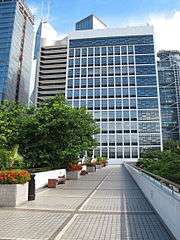

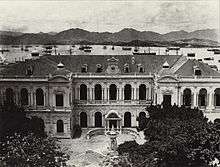
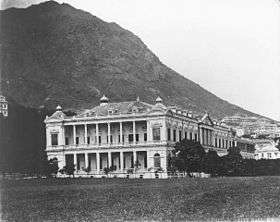
Hong Kong City Hall (Chinese: 香港大會堂) is a building located at Edinburgh Place, Central, Hong Kong Island, Hong Kong.
Since Hong Kong is a "Special Administrative Region" and not a normal Chinese city, there is no mayor or city council; therefore, the City Hall does not hold the offices of a city government, unlike most city halls around the world. Instead, it is a complex providing municipal services, including performing venues and libraries.
The City Hall is managed by the Government's Leisure and Cultural Services Department. The Urban Council managed the City Hall (through the Urban Services Department) and held its meetings there prior to its dissolution in December 1999. Prior to its dissolution the UrbCo served as the municipal council for Hong Kong Island and Kowloon (including New Kowloon). The UrbCo had its meeting chamber in the Low Block of the City Hall.
First generation
Hong Kong's first City Hall, which existed from 1869 to 1933, occupied the current sites of the HSBC Hong Kong headquarters building (partly) and the Bank of China Building.[1] The current site of the HSBC Hong Kong headquarters building was occupied in part by the old City Hall, and in part by the first and second generations of the HSBC building.
Design and function
The City Hall was built on Government land, and funds were raised for its construction, which started in 1866, from public subscriptions. The two-storey hall was designed by Me A. Hermite, a French architect,[1][2] in a Renaissance style, with cupolae, colonnades and arches. The facilities available for use by the local community included a theatre, library, museum and assembly rooms.[1] A fountain, sponsored by Dent & Co. was located at the front (south side) of the Hall. The building was inaugurated by HRH Prince Alfred, Duke of Edinburgh on 28 June 1869 on his visit to the colony.
The land was acquired by the Hong Kong Bank in 1933 for its third generation headquarters, so that the western part of City Hall was pulled down. The remaining part was demolished in 1947 to make way for the Bank of China Building.[1]
Second generation
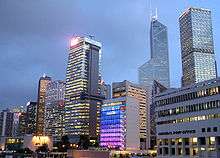
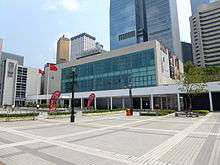
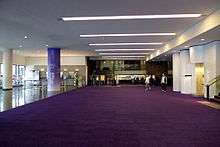
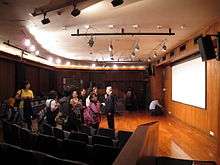
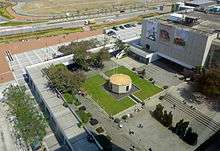
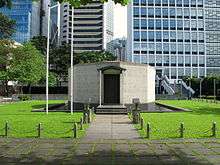


The second and current City Hall complex was built in the late 1950s on a 10,000 square metres (110,000 sq ft) plot of land on the newly reclaimed seafront, about 200 metres (660 ft) from the first generation building. It officially opened on 2 March 1962 by then Governor Robert Brown Black. It was placed under the responsibility of the Urban Council. The City Hall has been listed as a Grade I historic building since 2009.[3]
Design
It was designed in 1956, by British architects Ron Phillips and Alan Fitch.[4] With its clean lines and stark geometric forms, the new Hall is an example of the International style fashionable at the time. The structure was constructed using steel and concrete, and much of the equipment was of steel, glass and anodised aluminium.[1]
The two separate blocks and gardens were laid out as a cohesive whole, along a central axis. The entrance to the lower block (exhibition hall) of the City Hall formed an axis with Queen's Pier to lend a sense of occasion to visiting dignitaries. One major consideration was juxtaposing the city bustle whilst maximising public access to the surrounding area. Thus, the out-sized public areas of the Memorial Gardens and the piazza in front were conceived as a natural extension to promote the "freedom of movement and a sense of unlimited space".[4]
Function
The most important civic function performed by City Hall was as a ceremonial location for the swearing in of successive Governors following their inauguration.[5]
City Hall's Concert hall and theatre have been an important home to the performing arts in Hong Kong since its inauguration. A number of culture events, including the Hong Kong Festival, Hong Kong Arts Festival in 1973, Asian Arts Festival in 1976, the Hong Kong International Film Festival in 1977, and the International Arts Carnival in 1982 were hosted there. The conference room of the former Urban Council was also at the lower building of the City Hall.
The High block once housed Hong Kong's principal public library, until a new Central library was opened in 2001; the Hong Kong art gallery (which became the Hong Kong Art Museum in 1969) began life there on the tenth and eleventh floors. The Hong Kong Museum of History relocated in 1975, and the Hong Kong Museum of Art also moved out of City Hall in 1991.
The City Hall Memorial Garden at the north-western quadrant is a walled garden (for pictures see below). It is a popular spot and obligatory backdrop for photographs of couples who celebrate their marriage in the City Hall Registry. Within the garden is a regular dodecagon shrine with an embedded memorial (Roll of Honour and Plaque) to those killed in Hong Kong during World War II (1941–1945).
Summary of facilities
The complex has two buildings and a garden.
The High Block, a 12-storey building, is in the south-western end and houses a number of government facilities, including:
- City Hall Public Library, an eight-storey facility, which in the past served as the central library of Hong Kong (on the 9th – 11th floors)
- Exhibition Gallery, 260 square feet (24 m2).
- Recital Hall with 111-seats.
- Committee Rooms: two 40-seat committee rooms (on the 7th floor)
- Marriage Registry (on the 1st floor)
- Fast food restaurant, managed by Maxim's Catering: MX
The 3-storey Low Block is at the eastern end, with the following facilities:
- Concert Hall, with 1,434 seats and 60 standees at the mezzanine level.
- Restaurants and a cafe, managed by Maxim's Catering: continental (Deli and Wine), Chinese (City Hall Maxim's Palace) and European (City Hall Maxim's Café) cuisines
- The URBTIX Box Office
- Exhibition Hall, 590-square metres.
- Theatre with 463 seats.
- Performing Arts Shop
- an enquiry counter
High Block floor directory
| 11th floor |
Reference Library / Business and Industry Library Multimedia Resource Centre |
|---|---|
| 10th floor |
Reference Library (Entrance) Creativity and Innovation Resource Centre |
| 9th floor |
Newspapers and Periodicals Reading Room |
| 8th floor |
Recital Hall Extension Activities Room |
| 7th floor |
Exhibition Gallery Committee Room South/North |
| 6th floor |
Computer and Information Centre Office of Computerization Unit, Hong Kong Public Libraries |
| 5th floor |
Basic Law Library Adult Lending Library |
| 4th floor |
Adult Lending Library |
| 3rd floor |
Adult Lending Library (Entrance) Circulation Counter |
| 2nd floor |
Junior Library |
| 1st floor |
Marriage Registry |
| Ground floor |
Library Cloakroom |
See also
Other civic centres in Hong Kong:
Nearby sites:
- HMS Tamar
- Chater Garden
- Statue Square and the Cenotaph
- HSBC Hong Kong headquarters building
- Former Supreme Court Building
References
- 1 2 3 4 5 EIA: A survey report of Historical Buildings and Structures within the Project Area of the Central Reclamation Phase III, Chan Sui San Peter for the HK Government, February 2001
- ↑ "Building Together: 160 Years of Hong Kong – French Common Heritage and Perspectives" Exhibition leaflet
- ↑ List of the 1,444 Historic Buildings in Building Assessment (as of 27 December 2013)
- 1 2 Heron, Liz (13 May 2007). "Save Queen's Pier, says architect of City Hall complex". South China Morning Post. p. 4.
- ↑ Annexe B3, EIA: A survey report of Historical Buildings and Structures within the Project Area of the Central Reclamation Phase III, Chan Sui San Peter for the HK Government, February 2001
- Further reading
- City Hall: 30th anniversary. A platform for the arts. Hong Kong: Urban Council. 1992.
- Hong Kong City Hall, 1962-1982: Twenty years in retrospect. Hong Kong: Urban Council. 1983.
External links
| Wikimedia Commons has media related to City Hall, Hong Kong. |